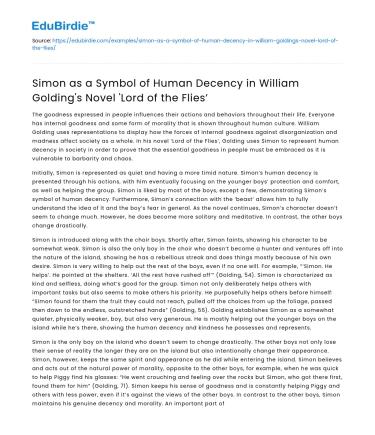The goodness expressed in people influences their actions and behaviors throughout their life. Everyone has internal goodness and some form of morality that is shown throughout human culture. William Golding uses representations to display how the forces of internal goodness against disorganization and madness affect society as a whole. In his novel ‘Lord of the Flies’, Golding uses Simon to represent human decency in society in order to prove that the essential goodness in people must be embraced as it is vulnerable to barbarity and chaos.
Initially, Simon is represented as quiet and having a more timid nature. Simon’s human decency is presented through his actions, with him eventually focusing on the younger boys’ protection and comfort, as well as helping the group. Simon is liked by most of the boys, except a few, demonstrating Simon’s symbol of human decency. Furthermore, Simon’s connection with the ‘beast’ allows him to fully understand the idea of it and the boy’s fear in general. As the novel continues, Simon’s character doesn’t seem to change much. However, he does become more solitary and meditative. In contrast, the other boys change drastically.
Save your time!
We can take care of your essay
- Proper editing and formatting
- Free revision, title page, and bibliography
- Flexible prices and money-back guarantee
Simon is introduced along with the choir boys. Shortly after, Simon faints, showing his character to be somewhat weak. Simon is also the only boy in the choir who doesn’t become a hunter and ventures off into the nature of the island, showing he has a rebellious streak and does things mostly because of his own desire. Simon is very willing to help out the rest of the boys, even if no one will. For example, “‘Simon. He helps’. He pointed at the shelters. ‘All the rest have rushed off’” (Golding, 54). Simon is characterized as kind and selfless, doing what’s good for the group. Simon not only deliberately helps others with important tasks but also seems to make others his priority. He purposefully helps others before himself: “Simon found for them the fruit they could not reach, pulled off the choices from up the foliage, passed then down to the endless, outstretched hands” (Golding, 56). Golding establishes Simon as a somewhat quieter, physically weaker, boy, but also very generous. He is mostly helping out the younger boys on the island while he’s there, showing the human decency and kindness he possesses and represents.
Simon is the only boy on the island who doesn’t seem to change drastically. The other boys not only lose their sense of reality the longer they are on the island but also intentionally change their appearance. Simon, however, keeps the same spirit and appearance as he did while entering the island. Simon believes and acts out of the natural power of morality, opposite to the other boys, for example, when he was quick to help Piggy find his glasses: “He went crouching and feeling over the rocks but Simon, who got there first, found them for him” (Golding, 71). Simon keeps his sense of goodness and is constantly helping Piggy and others with less power, even if it’s against the views of the other boys. In contrast to the other boys, Simon maintains his genuine decency and morality. An important part of the book is when Simon realizes the beast is not real: “The beast was on its knees in the center, its arms folded over its face” (Golding, 152). Simon, after fully understanding the roots of the beast, tries to explain to the boys his findings. As a result, Simon is murdered, and this scene represents a loss of humanity and purity, as well as chaos and destruction overpowering human morality.
The unmerciful murder of Simon takes place following his discovery of the beast’s true form. Simon comes to realize that the beast is just a remnant of their internal fear: “Maybe there is a beast...maybe it’s only us” (Golding, 89). Simon suggests that there is a beast, just not what they think it is. Rather than viewing the beast as some form of external monster, Simon suggests that each boy has space for fear that has been used to convert into one physical beast. Furthermore, the beast is a symbol of the savagery that lurks within each boy. Simon is murdered after he comes back to explain his conclusions as the boys mistake him for the beast, representing the triumph and victory of evil over good, as well as the scarcity of goodness on the island: “The world, that understandable and lawful world, was slipping away” (Golding, 91). The boys start to lose all connection with reality and their sense of civilization and morals, and after Simon’s death, the connection is gone, as the remaining human decency is gone.
The demonstration of the goodness in people is used throughout William Golding’s novel ‘Lord of the Flies’ to display the consequences without it and how civilization uses it. The character Simon as a symbol of goodness plays a major part in the story. The development of Simon’s actions and thoughts present how his character affects the civilization on the island, with his help in making shelter, to the events leading up to his death. With Golding’s general idea and presentation of goodness in people, he adds a sense of reality that is shown outside of the book and in our society; that is, goodness and saintliness don’t necessarily overpower destruction and chaos, yet these positive qualities in people can exist even in the presence of chaos.






 Stuck on your essay?
Stuck on your essay?

